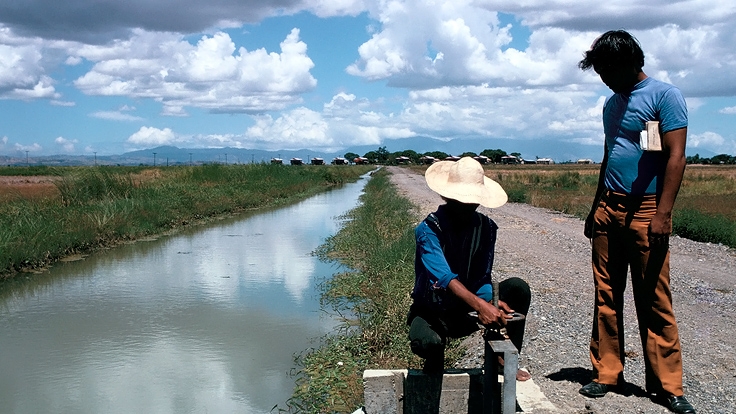Challenge
Water is one of the most basic human needs and is indispensable to almost all economic activities, including agriculture, energy production, industry, and mining. With impacts on health, gender equity, education and livelihood, water management is crucial to sustainable economic development and the alleviation of poverty. Yet water is under unprecedented pressures as growing populations and competing economic sectors demand more of it leaving insufficient water to meet human needs, as well as sustaining the environmental flows that keep our ecosystems healthy. Groundwater reserves are depleted in many places, leaving current and future generations with close to no buffer against increased climate variability.
Worsening water quality resulting from a wide range of economic activities is reducing the available amount of fresh water, degrading land, impacting many terrestrial and marine ecosystems, and adding to the costs of water treatment. Access to safe sanitation and water is still out of reach for 2.5 billion and 768 million people respectively, leading to thousands of lives lost daily and billions of dollars in economic losses annually.
Ample evidence exists that climate change will exacerbate the challenge by increasing hydrologic variability which will result in more frequent and intense weather events like droughts, floods and major storms. Experts estimate that by 2080, 43 to 50 percent of the global population will be living in water-scarce countries, compared to 28 percent today. A recent World Bank report, Turn Down the Heat: Why a 4°C world must be avoided, suggests that in a 4°Celsius warmer world, water stress will increase in areas around the world. The roughly 1 billion people living in monsoonal basins and the 500 million people living in deltas are especially vulnerable. The poorest people will suffer the most and are the least prepared.
Water-resources management issues have become so pressing that the World Economic Forum named water as one of its top challenges two years in a row, in 2013 and 2014. Within this changing physical and socio-economic landscape, water practices of the past are no longer adequate. Countries cannot grow sustainably, or strengthen their resilience to climate change, without smart water management that takes into account decreasing water availability and quality, and the need for deliberative allocation based on social, environmental, and economic needs.
Global water challenges require multi-sectoral solutions:
- Water and agriculture: By 2050 the world will need to feed 9 billion people — 2 billion more than today’s population. This will result in a 50 percent increase in agricultural production and a 15 percent increase in already-strained water withdrawals. Already, the agricultural sector is by far the largest global user of water. Irrigated agriculture accounts for about 70 percent of total freshwater withdrawals worldwide. Yet, water is becoming increasingly scarce as a result of continued population growth, declining groundwater supplies and water quality issues. Climate change will worsen the situation by increasing water stress. Poorer countries contributing least to the problem will be most affected.
- Water and energy: Today, over 1.2 billion people lack access to electricity. Currently, water withdrawals for energy are estimated at around 15% of global water withdrawals. At the same time, estimates show that by 2035, global energy consumption will increase by 35%, and while water use will become more efficient, actual water consumption by the energy sector may increase by 85%.
- Water and sustainable cities: over the next 20 years, cities in developing countries will double and so will their demand for integrated approaches to managing water supply, water quality, sanitation, drainage, recreational use, and flood management.
- Water and disaster risk management: Many of the impacts of natural disasters on socio-economic development occur through water. Water-related hazards account for 90% of all natural hazards, and their frequency and intensity is generally rising. Some 373 natural disasters killed over 296,800 people in 2010, affecting nearly 208 million others and costing nearly US$110 billion (Source: United Nations Secretary General Report to the 66th General Assembly on the Implementation of the International Strategy for Disaster Reduction. New York, UN).
- Water and sanitation: at least 2.5 billion and 768 million people remain without access to improved sanitation and water, respectively. Providing these services sustainably requires integrated planning and management, including securing a quality water supply.
Most economic activities (e.g. agriculture, energy, industry, and mining) affect not only the quantity but also the quality of water resources, thereby further limiting water availability. Allocation of limited water resources among competing economic sectors and environmental water needs will be an increasing challenge for many countries. Failing to establish appropriate allocation mechanisms will impede development, resulting in increased income inequality and exacerbating environmental pressures.
Solution
The World Bank is positioned to play a key role by working across sectors and countries to help communities build resilience to climate change through integrated water resources management (WRM). The Bank is one of the key providers of knowledge and technical assistance on water. It is the largest multilateral donor for water development with a water portfolio accounting for 18 percent of its overall portfolio (representing 32 billion dollars in active commitments) as of 2014, with a clear focus on building foundations for shared prosperity and poverty alleviation.


